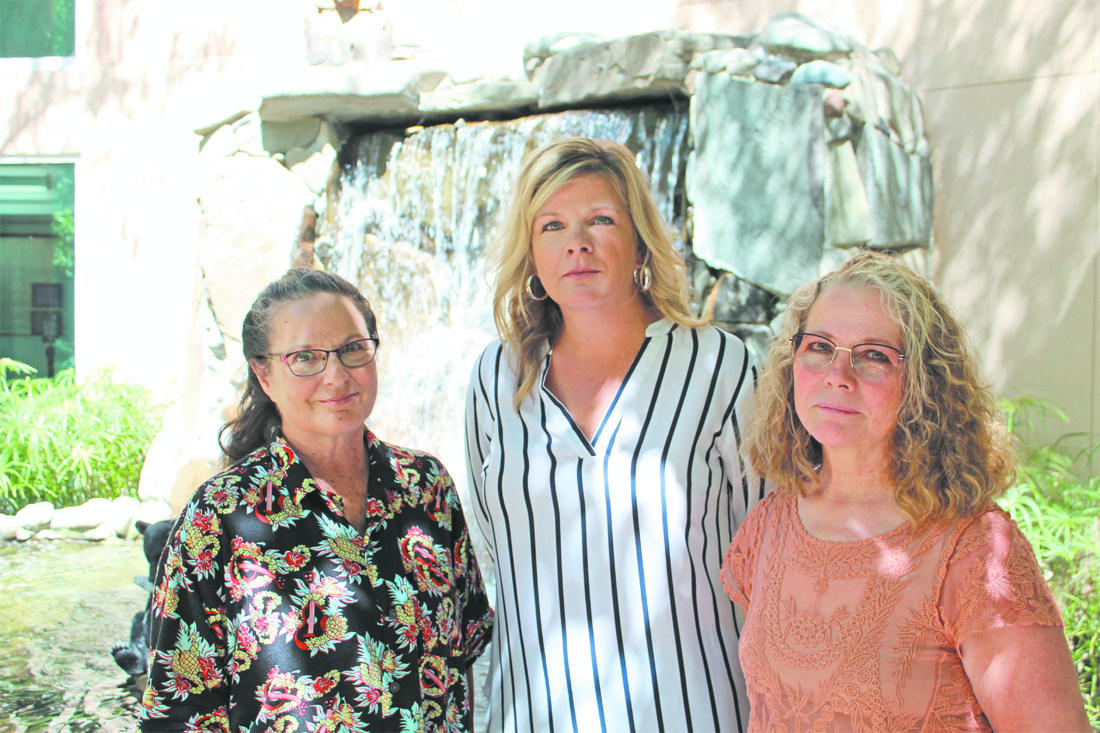
Photo by Ashiah Scharaga
Butte Valley neighbors (left to right) Danny Cuneo, Ryann Newman and Gail Tozier attend the latest meeting between local agencies and Miocene Canal water users. Newman says she’s incredibly frustrated by the process.
Ryann Newman had to move about two dozen horses and ponies off her property when PG&E stopped diverting water to the Miocene Canal after it was damaged during the Camp Fire. That’s because the creek that flowed through her family’s land had been fed by the Miocene, a significant source of water for their operations in Butte Valley (she and her husband own Aloha Ranch Inc., which includes Ryann’s Happy Day Pony Ride, and Fruit Caboose Concessions). Now the creek is barren, her fields are parched and her orchard is dry.
PG&E, which owns the upper and middle portions of the canal, started delivering water this month—up to 5,000 gallons per household per week. But Newman’s family doesn’t qualify. Unlike her neighbors, she is not a contracted water user—she’s one of an untold number of folks living along the 25-mile-long canal whose property has been fed by the Miocene for generations. It’s created creeks, streams and ponds, sustained habitat, supported wells and agricultural operations. Newman and other water beneficiaries who joined the Miocene Canal Coalition, an advocacy group, have argued the number of people reliant on that water easily could be in the hundreds, even the thousands, just based on nearby parcels.
On Monday (July 22), during a meeting between Miocene water users and stakeholders, Mike Schonherr, PG&E director of strategic agreements, said the utility is delivering only to the dozen users who have contracts with PG&E, but is willing to evaluate requests.
The meeting was part of a series intended to carve a path forward for Miocene users, but it’s been a difficult, tense journey. Aside from the water deliveries (which Newman’s neighbors confirmed don’t provide enough water for their livestock), solutions that will sustain their households and in many cases livelihoods have yet to be found. PG&E has chosen not to repair the damaged portion of the canal due an estimated $15 million price tag, but even the repair of the system would be a years-long undertaking.
On Monday, coalition members continued to press PG&E and the county for concrete solutions—Ed Cox, the coalition’s spokesman, asked PG&E to reply to a simple question: Will it fund the build-out of an approximately $1.2 million pipe? The idea is to allow Del Oro Water Co. to siphon enough water from Lake Oroville to feed the undamaged portion of the Miocene. The canal typically diverts water from the Feather River—since Nov. 8, that water has continued to flow down the river into Lake Oroville. Paradise Irrigation District and Del Oro also are exploring a partnership, but it could require infrastructure upgrades.
Schonherr said he’d relay that question to his superiors.
Bob Fortino, CEO of Del Oro, said that could meet the demand, but there’s a caveat: “It just needs more horsepower.” In other words, an additional cost of roughly $90,000 per month to pump the water into the canal.
PG&E still is negotiating the sale of its portions of the canal with Washington-based Tollhouse Energy Co. Schonherr said the canal itself has a “negative value.”
“The water is what is valuable, not the generation. The only way that it makes sense economically is if the new owner could come in and monetize the water,” he said. “The challenge with that is the leaky canal. All the water goes down the canal to meet the needs, so there’s none left over to sell.”
Tensions mounted as the group circled potential solutions and threw out others, escalating to the point where coalition members threatened litigation.
“The fact of the matter is, if things aren’t sped up, it’s just better to litigate,” Cox said. “If we’re going to burn the clock, [we] might as well burn the clock fighting in court.”
Paul Gosselin, director of the county’s Department of Water and Resource Conservation, said folks “are duly frustrated with how long this has taken,” but that the county is going to continue exploring solutions.
Other options that will be examined include extending Del Oro’s service area to cover residents who’ve used Miocene water. Gosselin said he’d reached out to the Thermalito Water and Sewer District about the possibility of utilizing the decommissioned Wilenor Ditch, which historically fed the canal.
Landowners likely will be expected to chip in for ongoing maintenance moving forward, Gosselin said. Water users could vote to create a community service district through the Butte Local Agency Formation Commission, but the actual number of those who rely on the canal must be identified. The county is poised to receive a $60,000 grant from PG&E that could help answer that question. Another $20,000 from the U.S. Department of Agriculture likely would be used to survey landowners and help them apply for assistance programs.
The next Miocene meeting has been scheduled for early August.
Newman did not walk away on Monday feeling hopeful: She said she feels that the concerns of a group of “podunk people” are being dismissed in light of the larger disaster. But for her, this also is a matter of life and death.
“The new fire hazard that’s being created right now, people are underestimating,” she told the CN&R. “How scary is it now for us to live there?”
For that same reason, state Sen. Jim Nielsen and Assemblyman James Gallagher have taken an interest. The representatives sent a letter to Cal Fire arguing that the Miocene Canal is a “vital component” of that area’s fire suppression system.
It states: “We are asking you to consider the importance of these waterways in protecting these regions from devastating wildfires.”
